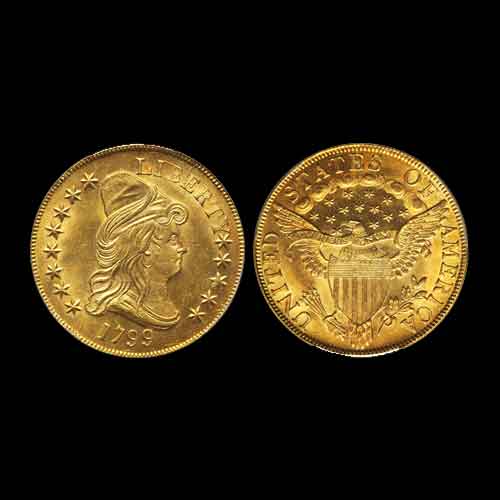Heritage’s Long Beach Coin Auction Displays a Pair of Coins, Awaiting Bidders
2018-02-06 Tue
Heritage’s auctions held in conjunction with the Long Beach Coin, Currency, Stamp & Sports Collectible Show in Southern California displays a pair of coins from the early years of the U.S. Mint that is awaiting bidders.One fantastic offering is the Elder example of the 1794 Flowing Hair silver dollar, graded Very Fine 35 by PCGS. Its first recorded offering was in a Sept. 3, 1910, Thomas Elder auction where it was photographed as part of the Peter Mougey Collection and described simply as, “Head of Liberty undraped. Standing eagle. About Fine. Extremely rare” and it realized a then-robust $150. Of course, grading standards were different in the early 20th century and numismatists know much more today about the production characteristics of the issue.
At the Heritage’s January 2007 Platinum Night auction at the Florida United Numismatists convention, the Elder Dollar crossed the auction block and got sold for $207,000. It can be traced by a small planchet flaw between the eighth star and the 1 in the date on the obverse, and a long, thin scratch from the top of OF to the top of AM on the reverse. There are a few scratches on each side along with faint adjustment marks near the obverse rims.
There is a high demand for 1794 Flowing Hair dollars as they represent the first year that silver dollars were struck at the Philadelphia Mint, and it is estimated that perhaps 150 survive from an originally delivered mintage of 1,758.
The 2010 book by Martin Logies of the Cardinal Collection Education Foundation, The Flowing Hair Silver Dollars of 1794: An Historical and Population Census Study, records 134 distinct examples. The issue holds the #20 ranking in the book 100 Greatest U.S. Coins by Jeff Garrett and Ron Guth, and many of the known examples have significant problems, like heavy cleaning, repairs or edge damage.
A 1799 Capped Bust, Heraldic Eagle gold $10 eagle graded MS-64 by PCGS is a lustrous example. Listed as the BD-7 variety of the date in the Bass-Dannreuther reference, it is the more common 1799 with Small Obverse Stars type, as distinguished in the “Red Book” from the 1799 Large Obverse Stars gold eagle.
The pristine surfaces of this brilliant lemon-yellow example have trivial, microscopic marks of no consequence, with a delicate peripheral rose patina that enhances the eye appeal.
Heritage concludes that with its blend of eye appeal and technical interest, this 1799 Capped Bust gold $10 is “a true prize for the connoisseur of early gold coinage.”
Latest News
-
Gold Pagoda of Vijaynagar Empire King Deva Raya I
2024-04-10 WedKing Deva Raya I of the Vijayanagara Empire was a patron of Kannada literature and architecture. He ...
-
Silver Denarius of Septimus Severus
2024-04-05 FriLucius Septimius Severus served as the Roman emperor from 193 to 211 AD. Severus sat on the throne o...
-
Extremely rare 'Malaharamari' type Gold Gadyana of King Guhalladeva-III Sold for INR 611000
2024-04-03 WedTribhuvanamalla, also known as Guhalladeva III, was the ruler of the Kadamba dynasty. His reign coin...
-
90 Years of RBI
2024-04-02 TueOn 1st April, PM #Modi unveiled a special commemorative coin marking 90 Years since the foundation o...
-
Silver Denarius of Julia Mamaea
2024-04-02 TueJulia Avita Mamaea, a Christian Syrian noblewoman, was the mother of Roman Emperor Alexander Severus...

